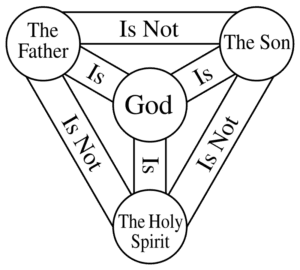National Association of Christian Ministers Manual to Ministry: Planning
The doctrine of the Trinity is one of the most profound and distinctive teachings of Christianity, encapsulating the complexity and depth of the Christian understanding of God. It posits that God exists as three persons—Father, Son, and Holy Spirit—each person being fully God, yet there is only one God. This foundational doctrine, while challenging to fully comprehend, is crucial for an accurate portrayal of the Christian faith in ministry. This article aims to offer insights and strategies for explaining the Trinity in a manner that is both accessible and theologically sound within the context of Christian ministry.
Understanding the Trinity #
Before one can explain the Trinity, it is essential to grasp its fundamental principles. The Trinity is not a contradiction, but a mystery that transcends human understanding. It does not suggest three gods (Tritheism) nor does it propose that God manifests Himself in three modes at different times (modalism). Instead, the Trinity affirms that within the one Being that is God, there exists eternally three co-equal and co-eternal Persons.
Biblical Foundations #
The doctrine of the Trinity is derived from a comprehensive reading of Scripture rather than a single verse. The Old Testament hints at a plurality within God (Genesis 1:26, Isaiah 6:8), while the New Testament provides clearer revelations of the Trinity’s dynamics (Matthew 28:19, 2 Corinthians 13:14). Jesus speaks of the Father, Son, and Holy Spirit with distinct roles yet a unified essence (John 14-16).
Strategies for Explaining the Trinity #
Explaining the Trinity in ministry requires a thoughtful approach that respects its complexity while making it relatable. Here are several strategies:
Use Analogies with Caution #
Analogies, while useful, are inherently limited and should be used with caution. Common examples include water (existing as ice, liquid, and vapor) or a single person being a father, son, and husband. While these can provide a starting point for understanding, it’s crucial to emphasize that all analogies fall short of fully capturing the essence of the Trinity. They are tools for beginning the conversation, not definitive explanations.
Emphasize Relationships #
The Trinity can be more relatable when explained in terms of relationship and community. The Father, Son, and Holy Spirit exist in eternal relationship with one another, perfectly united in will and purpose. This relational aspect mirrors the call for Christians to live in love and unity with one another (John 17:21-23). Highlighting the Trinity as a model for Christian community can help make the concept more tangible.
Focus on the Economic and Ontological Trinity #
Distinguishing between the “Economic Trinity” (how the Father, Son, and Holy Spirit work in the world) and the “Ontological Trinity” (the inner life and relationships within God) can be helpful. The Economic Trinity can be more accessible, as it relates to God’s actions in salvation history—creation (Father), redemption (Son), and sanctification (Holy Spirit). The Ontological Trinity, while more abstract, underscores the equal divinity and unity of the three Persons.
Incorporate Visuals and Symbols #
Visual aids, such as the Shield of the Trinity diagram, can offer a visual representation of the Trinity’s complex relationships. The diagram illustrates the truth of statements like “The Father is God, the Son is God, and the Holy Spirit is God,” while also showing that “The Father is not the Son, the Son is not the Holy Spirit, and the Holy Spirit is not the Father.” Visuals can act as helpful references in explaining the concept.

Utilize Scriptural Narratives #
Narratives from Scripture that demonstrate the Trinity in action can be compelling. For example, the baptism of Jesus (Matthew 3:16-17) shows all three Persons involved in a singular event—the Father speaking from heaven, the Son being baptized, and the Holy Spirit descending like a dove. Such narratives illustrate the distinct roles yet united purpose of the Trinity.
Address Common Misunderstandings #
Clarifying what the Trinity is not can be as important as stating what it is. Addressing common misconceptions (such as modalism or tritheism) head-on can prevent confusion and deepen understanding. This also includes discussing the limitations of human language and analogies in fully capturing the divine mystery.
Foster an Atmosphere of Wonder and Worship #
Ultimately, the Trinity should inspire awe and worship. Encouraging a sense of mystery and reverence towards the divine nature of God can be more fruitful than insisting on complete understanding. The Trinity reminds us of the infinite depth of God, inviting us into a relationship with a Being who surpasses our comprehension yet desires to be known by us.
Practical Applications in Ministry #
In ministry, the doctrine of the Trinity has profound implications for worship, community life, and the Christian identity:
-
-
- Worship: Worship services can be designed to reflect Trinitarian beliefs, invoking the Father, Son, and Holy Spirit in prayers, songs, and liturgies.
- Community: The relational aspect of the Trinity models how Christians are to relate to one another, emphasizing unity, love, and mutual submission.
- Identity: Understanding the Trinity can deepen believers’ sense of identity as children of the Father, redeemed by the Son, and indwelt by the Holy Spirit.
-
Conclusion #
Explaining the Trinity in Christian ministry is no small task, given its complexity and the mystery surrounding the divine nature of God. However, by employing thoughtful strategies, emphasizing relational aspects, and fostering a sense of wonder, ministers can convey the beauty and depth of the Trinitarian doctrine. Through such teachings, believers can gain a richer understanding of God’s nature, leading to a deeper worship experience and a more profound sense of community and identity within the body of Christ. The Trinity, though beyond full human comprehension, remains a central and enriching doctrine that underpins the Christian faith and life.





